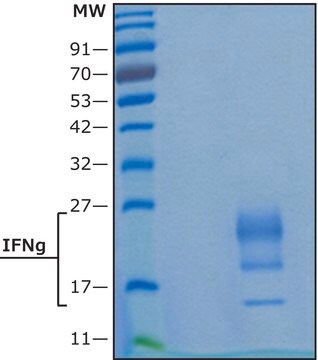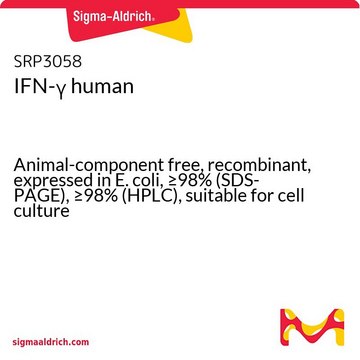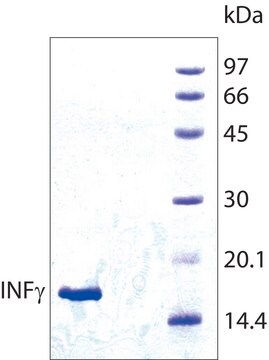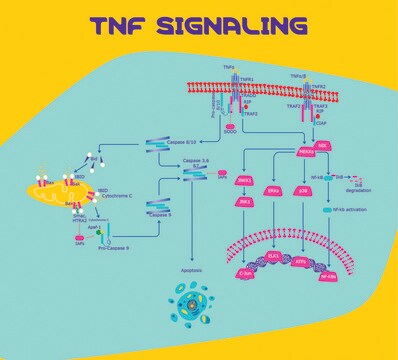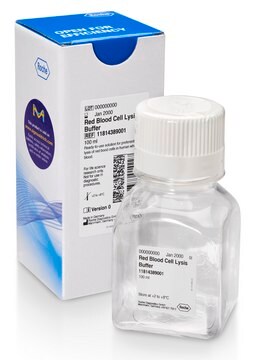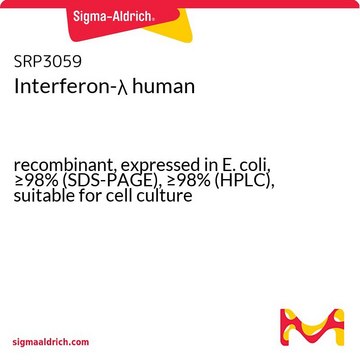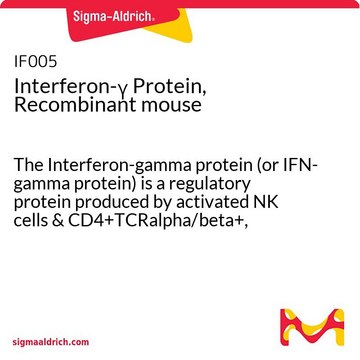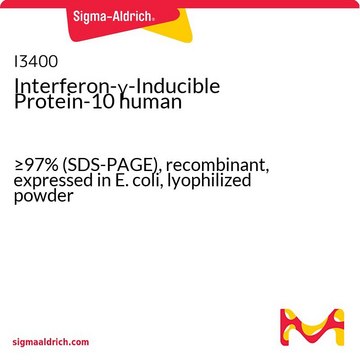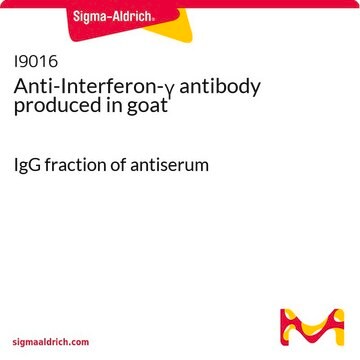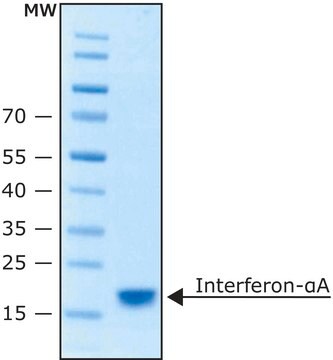11040596001
Roche
Interferon-γ, human (hIFN-γ)
from human, 95% (SDS-PAGE), solution, >2 x 10^7 U/mg
Sinónimos:
SYBR, qPCR
Iniciar sesiónpara Ver la Fijación de precios por contrato y de la organización
About This Item
Código UNSPSC:
12352207
Productos recomendados
origen biológico
human
Nivel de calidad
recombinante
expressed in E. coli
descripción
recombinant (E. coli)
Ensayo
95% (SDS-PAGE)
Formulario
solution
potencia
<0.05 ng/mL EC50
actividad específica
>2 x 10^7 U/mg
mol peso
16,700 Da
envase
pkg of 100,000 U (5 μg, 1 ml)
fabricante / nombre comercial
Roche
condiciones de almacenamiento
avoid repeated freeze/thaw cycles
impurezas
<0.1 EU/μgtested (LAL test)
Nº de acceso UniProt
temp. de almacenamiento
−20°C
Información sobre el gen
human ... IFNG(3458)
Descripción general
IFN-γ is produced by T-lymphocytes stimulated by antigen or by T-cell mitogens. Under nondenaturating conditions its molecular weight values range from 32,000 to 73,000 indicating that recombinant human IFN-γ exists as a dimer or higher oligomers.
Especificidad
Human IFN-γ is effective on human cells, but not on mouse or rat cells.
Aplicación
Interferon-γ, human (hIFN-γ) has been used to stimulate mesenchymal stem cells (MSCs). It has also been used as a supplement Dulbecco′s modified Eagle′s medium/Ham′s medium for the cultivation of human colorectal carcinoma cell line T84 cells.
Interferon-γ, human (hIFN-γ), can be used to investigate IFN-γ activities in human cell systems.
Acciones bioquímicas o fisiológicas
A broad range of biological activities has been attributed to IFN-γ (e.g., the establishment of the antiviral state, immunoregulatory functions, antiproliferative effects and inhibition of cell growth). The anti-proliferative effects of IFN-γ are superior to those of either IFN-α or IFN-β. Growth inhibition is dependent on cell type, dose, and length of exposure. One of IFN-γ′s primary functions might be as an immunoregulatory agent: IFN-γ induces MHC antigens on many cells, Fc-receptors on monocytes and macrophages, IL-2 receptors on T-cells, enhances activity of macrophages, polymorphonuclear leukocytes, T-lymphocytes, and NK-cells (MAF), and is also involved in the regulation of B-cells.
Interferon-γ (IFN-γ) is an essential component of acquired immunity. A broad range of biological activities has been attributed to IFN-γ (e.g., the establishment of the antiviral state, immunoregulatory functions, antiproliferative effects and inhibition of cell growth). The anti-proliferative effects of IFN-γ are superior to those of either IFN-α or IFN-β. Growth inhibition is dependent on cell type, dose, and length of exposure. One of IFN-γ′s primary functions might be as an immunoregulatory agent: IFN-γ induces MHC antigens on many cells, Fc-receptors on monocytes and macrophages, IL-2 receptors on T-cells, enhances activity of macrophages, polymorphonuclear leukocytes, T-lymphocytes, and NK-cells (MAF), and is also involved in the regulation of B-cells.
Calidad
The raw material used for this preparation was tested for HBs antigen and for the presence of antibodies to HIV-1, HIV-2, and HCV found to be negative.
Endotoxin level: <0.1EU/μg (LAL-test), <10EU/ml (LAL-test)
Note: 1EU corresponds to 0.1ng
Endotoxin level: <0.1EU/μg (LAL-test), <10EU/ml (LAL-test)
Note: 1EU corresponds to 0.1ng
Secuencia
Chain Length 143 AA
The primary structure of recombinant human IFN-γ (143 amino acids) is identical to that of natural human IFN-γ (146 amino acids), however, recombinant IFN-γ has three amino acids less and is not glycosylated. Glycosylation is not essential for biological activity.
Definición de unidad
EC50 definition: The amount of hIFN-γ that is required to produce equivalent antiviral activity to that expressed by 1 unit of the NIH IFN-γ reference standard (Gg 23– 901-530) (WISH cells-EMC virus/cytopathic effect) (1 unit equals ≤0.05 ng/ml).
Forma física
100,000U/ml or 1,000,000U/ml of Human IFN-γ in 0.1M phosphate buffer saline (PBS) (pH 7.0), 2.5% sucrose (w/v), and 2.5% human serum albumin (HSA) (w/v), filtered through a 0.2μm pore size membrane.
Nota de preparación
Working solution: Solvent is recommended in double-distilled water.
Storage conditions (working solution): Stability in culture: Activity is present for at least 18 hours in culture medium.
Storage conditions (working solution): Stability in culture: Activity is present for at least 18 hours in culture medium.
Otras notas
EC 50 : <0.05ng/ml (hIFN-γ , NIH, reference standard, Gg 23–901-530)
For life science research only. Not for use in diagnostic procedures.
Código de clase de almacenamiento
12 - Non Combustible Liquids
Clase de riesgo para el agua (WGK)
WGK 1
Punto de inflamabilidad (°F)
No data available
Punto de inflamabilidad (°C)
No data available
Elija entre una de las versiones más recientes:
¿Ya tiene este producto?
Encuentre la documentación para los productos que ha comprado recientemente en la Biblioteca de documentos.
Los clientes también vieron
IFNgamma modulates human immunoglobulin receptor expression in lipoaspirate-derived mesenchymal stem cells
Laksmitawati DR, et al.
Medical Journal of Indonesia, 23(3), 127-132 (2014)
Reza Norian et al.
Veterinary research forum : an international quarterly journal, 6(4), 265-271 (2016-03-15)
This in vitro study was conducted to evaluate lymphocyte blastogenic and cytokine production by bovine peripheral blood mononuclear cells (PBMCs) stimulated with phytohemagglutinin (PHA), pokeweed mitogen (PWM) and concanavalin A (Con A) mitogens, by using tetrazolium salt and ELISA tests
Ilona E Keller et al.
Scientific reports, 5, 10230-10230 (2015-05-20)
Impaired immune function contributes to the development of chronic obstructive pulmonary disease (COPD). Disease progression is further exacerbated by pathogen infections due to impaired immune responses. Elimination of infected cells is achieved by cytotoxic CD8(+) T cells that are activated
Interferon-
Ellis TN, et al.
Immunology, 112, 2-2 (2004)
Anti-proliferative effect of IFN-gamma in immune regulation. II. IFN-gamma inhibits the proliferation of murine bone marrow cells stimulated with IL-3, IL-4, or granulocyte-macrophage colony-stimulating factor
Gajewski TF, et al.
Journal of immunology (Baltimore, Md. : 1950), 141, 2635-2642 (2019)
Nuestro equipo de científicos tiene experiencia en todas las áreas de investigación: Ciencias de la vida, Ciencia de los materiales, Síntesis química, Cromatografía, Analítica y muchas otras.
Póngase en contacto con el Servicio técnico